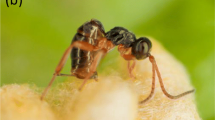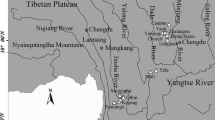Summary
Variation in the birth size of offspring of the terrestrial isopod, Armadillidium vulgare, was observed in laboratory experiments and in field populations. In the laboratory, larger offspring were produced when the mother's food supply was reduced. In field populations, larger offspring were produced during the summer, a period of reduced food availability. Smaller offspring are produced in the spring, when food is readily available. Females may be making larger young to increase survival during the more severe conditions of the summer breeding period.
Similar content being viewed by others
References
Barnes HH, Barnes M (1965) Egg size, nauplius size, and their variation with local geographical and specific factors in some common cirripedes. J Anim Ecol 34:391–402
Bayne BL, Holland DL, Moore MN, Lowe DM, Widdows J (1978) Further studies on the effects of stress in the adult of the eggs of Mytilus edulis. J Ma Biol Assoc UK 58:825–841
Brockleman WY (1975) The fitness of offspring and optimal clutch size. Am Nat 109:677–699
Brody MS (1980) Reproductive adapations to food shortages in the terrestrial isopod, Armadillidium vulgare. Dissertation Univ of Texas at Austin
Edney EB, Allen W McFarlane J (1974) Predation by terrestrial isopods. Ecology 55:428–433
Efford IE (1969) Egg size in the sand crab Emerita analoga (Decapoda, Hippidae). Crust 16:15–26
Gould SJ (1982) Darwinism and the expansion of evolutionary theory. Science 216 (4544):380–387
Greenwood SM (1977) Some effects of oil pollution on the growth rate “r” of a rotifer population. Masters thesis, Univ of Texas at Austin
Hart RC, McLaren IA (1978) Temperature acclimation and other influences on embryonic duration in the copepod, Pseudocalanus sp. Mar Biol 45:23–30
Helm MM, Holland DL, Stephenson RR (1973) The effect of supplementary algal feeding of a hatchery breeding stock of Ostrea edulis on larval vigor. J Mar Biol Assoc UK 53:673–684
Hislop JRG, Robb AP, Gauld JA (1978) Observations on effects of feeding level on growth and reproduction in haddock Melanogrammus aeglefinus in captivity. J Fish Biol 13:85–89
Kerfoot WC (1974) Egg size cycle of a cladoceran. Ecology 55:1259–1270
Lasenby DC, Langford RR (1972) Growth, life history, and respiration of Mysis relicta in an arctic and temperate lake. J Fish Res Bd Can 29:1701–7108
Lawlor LR (Unpublished manuscript) Feeding behavior in the terrestrial isopod, Armadillidium vulgare
Lawlor LR (1973) The ecology of reproduction in the terrestrial isopod, Armadillidium vulgare. Dissertation, The Univ of California at Berkeley
Lawlor LR (1976) Molting, growth, and reproductive strategies in the terrestrial isopod, Armadillidium vulgare. Ecology 57:1179–1194
Palmer J (1981) Resource seasonality and its size-specific life history consequences in the milkweed beetle, Labidomera clivicollis. Dissertation Univ of Texas at Austin
Paris OH (1963) The ecology of Armadillidium vulgare in California grassland: Food, enemies and weather. Ecol Mongr 33:1–22
Paris OH, Sikora A (1965) Radiotracer demonstration of isopod herbivory. Ecology 46:729–734
Paris OH, Pitelka FA (1962) Population characteristics of the terrestrial isopod Armadillidium vulgare in California grassland. Ecology 43:229–248
Schrode JB, Gerking DS (1977) Effects of constant and fluctuating temperatures on reproductive performance of a desert pupfish Cyprinodon nevadensis. Physiol Zool 50:1–10
Scott DP (1962) Effect of food quantity on fecundity of rainbow trout Salmo gairdneri. J Fish Res Bd Can 19:715–731
Smith CC, Fretwell DS (1974) The optimal balance between size and number of offspring. Am Nat 108:499–506
Sorenson EMB, Burkett RD (1977) A population study of the isopod, Armadillidium vulgare in northeastern Texas. Southwestern Nat 22:375–388
Strong D (1972) Life history variation among the populations of an amphipod. Ecology 53:1103–1111
Vandel A (1943) Essai sur l'origine, l'evolution et la classification des Oniscoidea (Isopodes, terrestres). Bull Biol France Belgique Suppl 30:1–143
Author information
Authors and Affiliations
Rights and permissions
About this article
Cite this article
Brody, M.S., Lawlor, L.R. Adaptive variation in offspring size in the terrestrial isopod, Armadillidium vulgare . Oecologia 61, 55–59 (1984). https://doi.org/10.1007/BF00379089
Received:
Issue Date:
DOI: https://doi.org/10.1007/BF00379089




